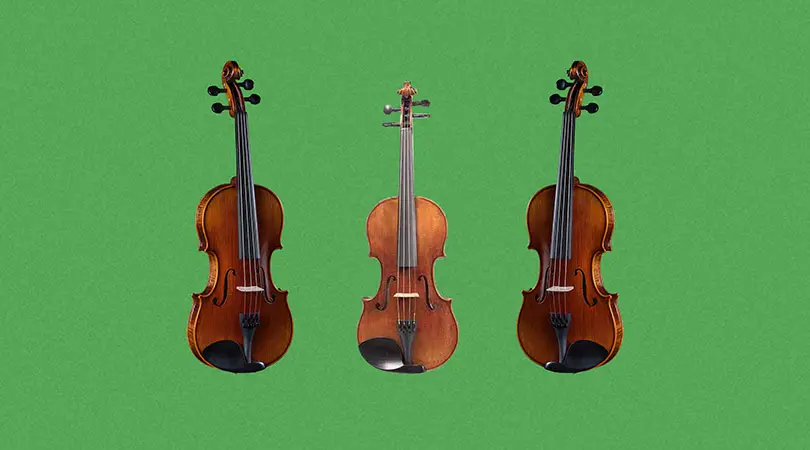Every orchestra will feature the four main string instruments: violin, viola, cello and bass. The range of these instruments go in descending order, with the violin having the highest pitch range and the bass the lowest.
In this guide, we’ll explore the differences between the two lower-range string instruments, the cello and the double bass.
Table Of Contents
How Are The Cello And Double Bass Different?
The cello and the bass are two instruments that look rather alike. They are both played with a bow, and have a similar shape to their bodies. A cello above average in size could, in fact, be mistaken for a double bass.
There are five key differences between a cello and bass that are important to take into account when deciding which instrument you should invest your time and money into: size, sound, tuning, playing position, and difficulty.
1. Size
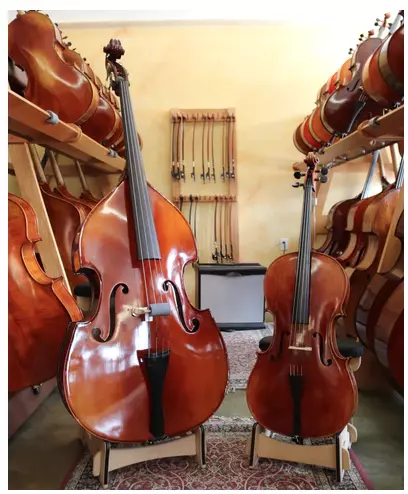
Credit: KC Strings
As you can tell in the picture above, a double bass is significantly larger than a cello. Like violins and violas, there are different sizes of cellos and basses according to age and player height. 4/4 is full-sized for most string instruments.
However, the majority of double basses are ¾ size, as the 4/4 is viewed as the “jumbo” version for very tall players.
A 4/4 cello is typically 47.64 inches (121 centimeters) and a 3/4 double bass is typically 71.6 inches (182 centimeters).
While 4/4 cellos and ¾ basses are the most common options, you still want to make sure you consider the proper measurements before choosing your size, as sizing measurements for cello and bass are taken differently.
Sizing for cello
As you would for a violin or viola, you find your cello size by measuring the distance from your neck to your palm, with your arm extended straight like in the illustration below.
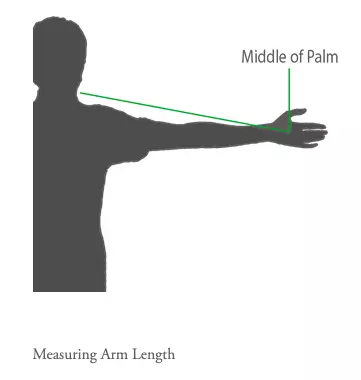
Credit: Luthier Shop
A player with a length of 24 inches or above will need a 4/4 cello. One with a length of 22 to 24 inches will require a ¾. 20 to 22 inches best suits a ½ size and with 18 to 20 inches a ¼ cello would be best.
Sizing for double bass
When you are sizing a player for a double bass, more often than not you should go by height rather than arm length, largely due to the fact that double bass is played standing up.
Additionally, hand size is a factor as well given the thicker strings and large fingerboard. Hand size often correlates with a player’s height.
It’s important to know that sizing charts like the one below is a general guide and every player is different. If the bass you are sized for feels too big or small, then try a different size. You should always test out the feel of it in your hands before investing in an expensive instrument.
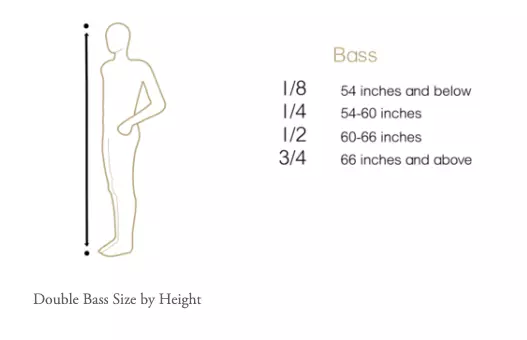
Credit: Luthier Shop
2. Tuning
Every string instrument has many different tuning options, but each one will have a standard tuning. The tunings will differ, as some stringed instruments have different ranges than others, like the cello and double bass.
Knowing the standard tuning of your instrument is one of the first steps you will need to take as a beginner, since you will always need to be in tune when you play.
Tuning is a similar process for most stringed instruments. The tuning pegs will be at the top of the instrument on the headstock. You will tighten the pegs to raise the pitch, and loosen to lower the pitch. Much easier than a tuning fork, you can buy a great clip-on tuner for under $20 or download a tuning app on your smartphone for free.
Cello standard tuning
Like the violin and viola, a cello’s standard tuning contains notes that are perfect fifths. This means that, starting from the lowest strings, each note is exactly five steps apart. The standard tuning for cello is:
C (C2) – G (G2) – D (D3) – A (A3)
Double bass standard tuning
The standard tuning for a double bass is a bit of an outlier from the rest of the stringed orchestral family (violin, viola, and cello), as it does not use a standard tuning based around perfect fifths. Rather, a double bass uses the same tuning as that of a guitar or electric bass:
E (E1) – A (A2) – D (D2) – G (G2)
Additionally, if you are performing a double bass solo piece in a classical setting, you will most likely use a different tuning. Beginners will not use this, but it is good to know the classical solo tuning:
F# (F#1) – B (B2) – E (E2) – A (A3)
3. Sound
Given that the double bass is in many ways a larger cello, their sounds do have some similarities. They are both bowed and plucked, with similar playing techniques. A cellist playing lower notes and a double bassist playing high notes can sound quite close to each other.
The simplest and clearest difference to their sound is that the double bass is much deeper. It has a bigger body with more hollow space, allowing for more resonation and lower octave play. The cello occupies the tenor range, warmer and deeper than a viola or violin, and can handle notes at a range too high for double bass.
The video below will give you a clear idea of how their sounds differ.
4. Playing Position
As seen in the video above, the cello and double bass are played in different body positions. The cellist is seated with the instrument between his legs, while the double bassist is standing with the instrument on his non-bowing side.
Cello playing position

Credit: The Strad
To properly play the cello, you must first be seated in a sturdy and firm chair. The majority of players prefer to sit at the edge of the seat, but you may use the backrest if needed, as long as you do not slouch.
You will adjust the cello’s bottom pin until the body rests against your chest, and the C-tuning peg next to your ear. You will use your knees to steady the instrument and angle it to the side so your bow can reach all the strings.
Double bass playing position
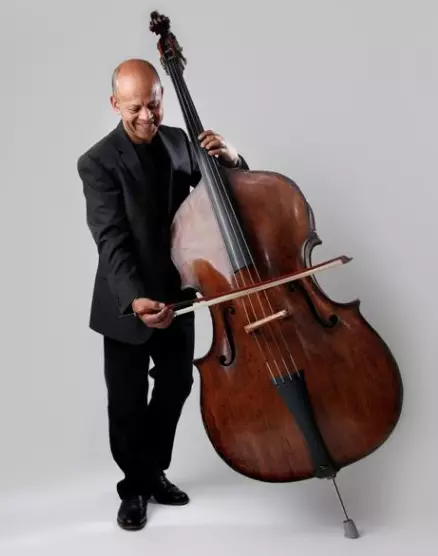
Credit: The Strad
You will play the double bass from a standing position, with your feet shoulder-width apart. The endpin on the bottom should be adjusted until the nut on the fingerboard is about level with your eyes (this can vary slightly due to preference).
Lastly, the bass should be positioned on the left side of your body and tilted back so that it leans against your left hip.
5. Price
As you might expect, due to the increased size and material needed, a double bass is significantly more expensive than a cello.
At the beginner level, the price discrepancy is a bit less, with a student cello on average costing around $1,000 while a student double bass would be closer to $2,000 on average.
Where they diverge is when you get to the professional sphere. Most professional-quality cellos will be somewhere in the range of $5,000-10,000. A professional quality double bass, however, will largely cost between $15,000-$20,000.
These prices are of course very high, which unfortunately is the norm for orchestral instruments. However, there are countless student rental options out there with both global brands like Sweetwater or with mom-and-pop music stores.
Frequently Asked Questions
Can you use the same bow for both instruments?
No. The cello uses a bow 10 centimeters longer than a bass bow. The cello’s bow is also three times as light, and is not strong enough to play heavy bass strings.
Which is better to learn?
Like many choices in music, it comes down to preference. If you like the idea of playing at the low range of orchestral instruments, then play double bass. If the pitch versatility of the cello appeals to you, choose that.
Which is harder, cello or double bass?
For a child or any other beginner, bass will be more difficult at first due to both its height and the size of the fingerboard. The size makes it harder to navigate with untrained fingers.
However, as you get into playing more advanced music, the cello parts in an orchestral piece are typically more difficult and technically complex.
